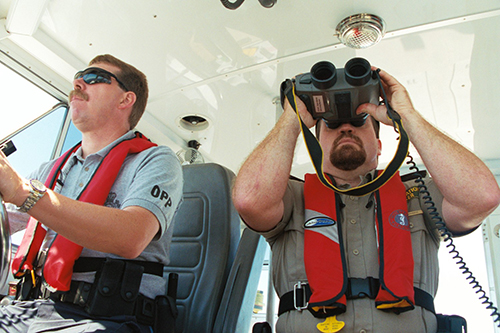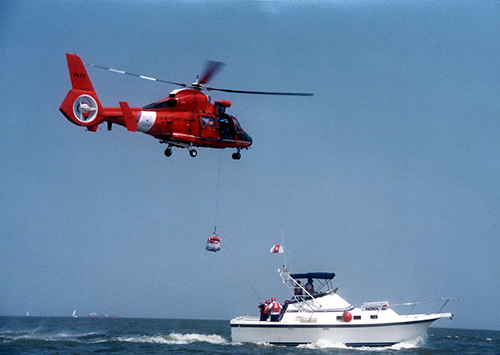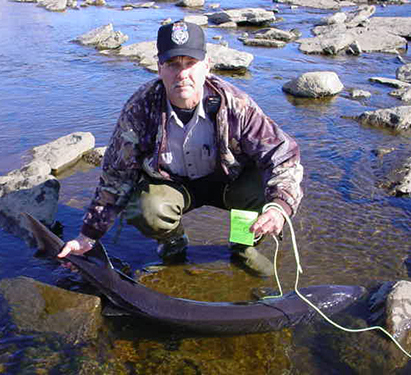Great Lakes Law Enforcement: Cooperating Across Boundaries to Protect the Fishery
Law enforcement is an important element of successful Great Lakes fishery management. Eight states, three U.S. intertribal agencies, one province and several federal agencies are responsible for developing, implementing and enforcing fishery regulations throughout more than 100,000 square miles of shared waters. These regulations address a range of activities including preventing over-harvest, restricting the movement of invasive species, and mitigating habitat destruction.

With many issues threatening this large, ecologically and politically complex area, policies are difficult to develop, let alone enforce. Successful fishery management requires a cohesive approach to developing and implementing regulations, as well as on-the-ground enforcement of these regulations. The development of enforceable regulations requires fishery managers and enforcement officers to work together to improve compliance and deter violations.
Law enforcement officials on the Great Lakes today are more than the conventional game warden. Officers must be sensitive to the environment and to users alike. They must understand the regulations not only of their own jurisdiction, but also of other jurisdictions. They must be trained in traditional law enforcement and also be able to deal with the specific challenges of the Great Lakes region.
The Law Enforcement Committee
To help facilitate coordinated fishery management through A Joint Strategic Plan for Management of Great Lakes Fisheries (a multi-jurisdictional fishery management agreement), the jurisdictions created the Great Lakes Law Enforcement Committee. The committee protects, enhances, and promotes the safe and wise use of natural resources in the Great Lakes and serves as a conduit for the transfer of information between fishery managers and law enforcement agencies.
The Law Enforcement Committee is charged with:
- Maintaining each jurisdiction's interests in cooperative fishery enforcement activities and decisions.
- Sharing law enforcement information.
- Supporting investigations that cross jurisdictional lines.
- Developing consistent regulations and commensurate penalties among jurisdictions.
- Providing the necessary leadership to bring resolution to important enforcement issues.
- Developing strategies to effectively communicate with resource users.
- To help officers prepare for a wide range of enforcement issues, the Law Enforcement Committee organizes special training sessions for Great Lakes officers on everything from invasive species identification to information sharing.
Patrolling the Great Lakes
During the past several decades, officers have increasingly engaged in covert operations to protect Great Lakes resources from illegal harvest, invasive species, and other threats. Working through the Law Enforcement Committee, officers use newly developed tools such as technologically advanced surveillance and  forensic fish analysis along with customary techniques like joint patrols, tip lines, and stake-outs to enforce regulations.
forensic fish analysis along with customary techniques like joint patrols, tip lines, and stake-outs to enforce regulations.
Targeting illegal fishing
In May 2000, a Combined Enforcement Team consisting of officers from Ohio, Michigan, New York, Pennsylvania, U.S. Fish and Wildlife Service, U.S. Coast Guard, and Ontario embarked on an unprecedented mission called Operation Kingfisher to target illegal fishing on Lake Erie. Officers established lines of formal and informal communication and obtained critical information about fishery violations which led to the successful prosecution of fishing offenses. This mission proved that joint enforcement on the Great Lakes was possible and productive. Building on the lessons learned from Operation Kingfisher, officers throughout the Great Lakes routinely participate in combined enforcement efforts.
Lake Sturgeon: Protecting the gentle giant

Lake sturgeon are a valued part of the native fish community of the Great Lakes; they can live for more than 100 years, though they are slow-growing and reach maturity at ages older than most fish, making them vulnerable to unlawful activities. Problems like overharvest and illegal trade of sturgeon and caviar have taken their toll on this once abundant species. Sturgeon have declined precipitously during the last century and are now the target of concerted restoration efforts in every Great Lake. As part of this effort, the Law Enforcement Committee has worked to develop consistent harvest regulations throughout the basin and facilitated enhanced enforcement efforts to target illegal harvest and unlawful transportation across state and international boundaries.
Invasive Carps: The latest invasive threat
Two varieties of Invasive carps (silver carp and bighead carp) escaped from aquaculture facilities in the southern United States and have spread throughout many reaches of the Mississippi and Illinois River watersheds. Invasive carp have wreaked major economic and ecological havoc on the aquatic environment and have steadily moved northward toward the Great Lakes. In response to the high risk of invasive carp entering the Great Lakes basin, all non-federal jurisdictions enacted regulations prohibiting the importation, exportation, transportation, sale, purchase, and acquisition of live invasive carp. Because of this collective regional action, the states and tribal organizations in the basin worked effectively on a national scale to promulgate U.S. federal regulations that forbid any interstate movement or sale of these fish. Armed with strong regulations, officers have monitored the international border for illegal shipments of invasive carp and have successfully prevented thousands of pounds of live invasive carp from being sold in Ontario markets. Effective enforcement and successful prosecution of these violations serve as a strong deterrent.

